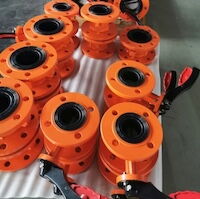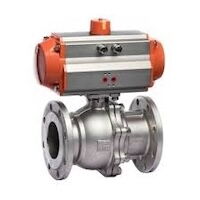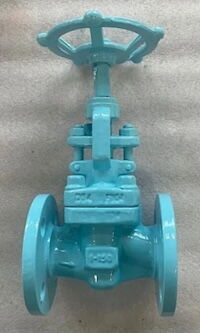Localization and Performance Optimization of Pneumatic Track Ball Valves for Marine Engineering
May 26, 2025
In response to the national initiative to localize key equipment for oil and gas pipelines, this paper focuses on the unique operating conditions and technical requirements of marine engineering. It highlights the critical role of pneumatic track ball valves in this sector and presents their design parameters and structural features. By analyzing real-world engineering applications, the study validates the soundness of the ball valve design and assesses its performance and reliability. The effectiveness of current applications is assessed and areas for further optimization are identified, outlining both the strengths of the existing design and potential directions for improvement. The paper concludes by summarizing the distinctive advantages of pneumatic track ball valves in enhancing the efficiency and safety of marine engineering and offers practical recommendations for their future application.
Pneumatic track ball valves, also known as pneumatic forced-seal ball valves or lifting-rod ball valves, are widely used in marine engineering due to their excellent sealing performance and fast opening and closing capabilities. They are particularly common in offshore oil and gas production, offshore platform pipelines, and marine environmental protection systems. However, because of the complexity of their design, material selection, and manufacturing process, most pneumatic track ball valves are still imported.
In 2012, China introduced a national initiative to localize key equipment for oil and gas pipelines, aiming to ensure a stable energy supply and revitalize the domestic equipment manufacturing industry. As part of this initiative, the valve localization program, including the track ball valve project, was officially launched. After more than a decade of development, the localization of manual track ball valves has been fully achieved. However, the localization of pneumatic track ball valves still requires further advancement.
Marine engineering is a multidisciplinary field focused on activities in the marine environment, encompassing marine resource development, environmental protection, and the construction and maintenance of marine engineering facilities. As the global economy continues to grow, reliance on marine resources is increasing, making marine engineering increasingly vital. The research and development of marine engineering rely heavily on interdisciplinary collaboration. It integrates fields such as fluid mechanics, materials science, marine ecology, and environmental science, serving as a key driver in the advancement of marine technologies. With the rapid development of artificial intelligence, the Internet of Things, and big data, the monitoring, maintenance, and management of marine engineering systems have seen significant improvements.
In harsh marine environments, pneumatic track ball valves offer enhanced reliability and safety. These valves perform consistently under high-pressure and low-temperature conditions and are typically constructed using materials like stainless steel or alloy steel, which provide excellent corrosion resistance and require minimal maintenance. Their opening and closing times can be flexibly adjusted based on specific valve characteristics and operating conditions. Moreover, high-precision control systems enable accurate valve operation, allowing them to adapt effectively to demanding environments. As science and technology continue to advance, the path toward sustainable marine engineering has become clearer. The concept of green engineering is increasingly being integrated into the design and execution of marine projects, aiming to strike a balance between resource development and environmental protection.
In exploring the role of pneumatic track ball valves in marine engineering, this study adopts a systematic research approach, taking into account both application requirements and reliability demands in extreme marine environments. Based on a thorough review and comparative analysis of existing valve technologies, along with real-world marine engineering conditions, this paper introduces for the first time a set of optimized design solutions for pneumatic track ball valves. These solutions are tailored to address the unique challenges posed by salt spray corrosion, seawater erosion, and temperature fluctuations in marine environments. This study quantitatively evaluates the fluid dynamic behavior of pneumatic track ball valves under various operating scenarios, using Computational Fluid Dynamics (CFD) simulations in conjunction with laboratory experiments that replicate marine conditions. Key performance indicators such as flow rate, pressure drop, and flow stability are assessed to ensure reliable valve function. Additionally, the paper introduces advanced surface treatment techniques, including cemented carbide coatings and superhydrophobic surface treatments, to enhance corrosion resistance and minimize biofouling. These innovations significantly improve the valve’s long-term operational performance in harsh marine conditions.
Given the need for pneumatic track ball valves to respond quickly under complex and variable pressure and temperature conditions, the study also incorporates intelligent control systems and real-time monitoring technologies. An efficient monitoring and early warning mechanism is established through the real-time collection and analysis of data such as valve opening and closing torque, actuation time, and sealing performance. This enables rapid and accurate assessment of valve health, allowing for timely adjustments or maintenance when anomalies are detected, thereby greatly enhancing overall safety and reliability. It is important to note, however, that despite their advantages in design and performance, pneumatic track ball valves still face challenges in terms of cost-effectiveness, equipment compatibility, and ease of maintenance in practical marine engineering applications. To address this, the study also conducts a comprehensive life cycle cost analysis and proposes an evaluation model based on life cycle cost-effectiveness, offering a more scientific basis for valve selection.
In conclusion, pneumatic track ball valves have demonstrated exceptional adaptability and reliability in marine engineering applications. The innovative designs and technologies presented in this study not only offer valuable theoretical insights and practical case studies for the advancement of valve technology in marine engineering, but also provide strong support for the technological progress and safe operation of related industries. Through rigorous experimental validation and data-driven analysis, the research findings presented here hold significant theoretical and practical value in driving innovation in pneumatic track ball valve technology and promoting the modernization of marine engineering equipment.
In marine engineering, pneumatic track ball valves are widely used due to their performance advantages in the following key areas:
Studies show that pneumatic track ball valves can achieve up to 99.8% sealing reliability in marine environments, significantly minimizing the risk of leakage. According to the NTC specification, these valves can open and close at a consistent speed under rated pressure, with actuation times ranging from 5 to 20 seconds, adjustable as needed. This responsiveness meets the fast reaction requirements commonly demanded in marine engineering applications.
Given the harsh conditions at sea, valve materials must offer excellent corrosion resistance. Commonly used materials include 316 and 316L austenitic stainless steel, F51 and F53 duplex stainless steel, and polytetrafluoroethylene (PTFE). These materials provide superior resistance to salt spray and other corrosive agents compared to standard materials. Test results indicate that 316, 316L, F51, and F53 stainless steels offer corrosion resistance in seawater for over 10 years. PTFE seals have demonstrated a service life of up to 15,000 operating cycles.
The selection of pneumatic actuators plays a critical role in valve performance. Depending on the load parameters and the operating environment, either single-acting or double-acting pneumatic actuators may be used. These actuators operate reliably within a pressure range of 500–1000 kPa and provide torque output 1.5 times that of the valve's required torque. To enable remote operation, the pneumatic system must also be equipped with essential components such as filter pressure-reducing valves, solenoid valves, air control valves, and speed regulators, as illustrated in Figure 1.
As intelligent marine engineering equipment continues to evolve, pneumatic track ball valves are increasingly integrated with intelligent monitoring systems. These systems utilize valve feedback devices (limit switches) to provide real-time information on valve status and position, enabling both remote control and data acquisition. The system can achieve a response time of less than 50 ms, meeting the demands of complex operations and enhancing overall engineering safety.
In the high and low temperature conditions typical of marine environments, the use of materials and structures with excellent thermal adaptability is essential. For example, the valve is designed to function reliably within a temperature range of –25°C to 80°C, maintaining stable operation even under extreme conditions. In conclusion, the pneumatic track ball valve is an ideal solution for fluid control in marine engineering due to its high reliability, corrosion resistance, and operational flexibility, fully meeting the industry’s stringent requirements for safety, efficiency, and intelligent functionality.

Figure 1. Pneumatic Air Circuit Diagram of Orbit Ball Valve
Previous: Impact of Valve Stem Surface Roughness on Packing Sealing Performance: Test Results and Analysis
Next: Optimized Valve Selection for Offshore Chemical Flooding Surface Facilities


